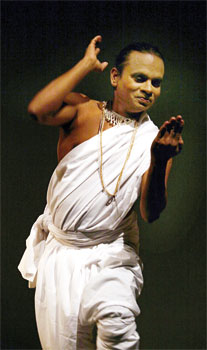Bringing to life women of traditional folklore
View(s):Director Dr. Asoka de Zoysa, explores the diversity of the female characters of local folklore tales, through contemporary dance and music in his latest production – ‘Saptanaari’
‘Saptanaari’ (Seven Women), to be staged later this month will bring to life the characters of seven women in traditional Sri Lankan theatre, exploring the ever-blurring lines between a woman’s chastity and character as represented through theatre historically. Directed by Dr. Asoka de Zoysa and presented by the Arpeggio Creative Dance Academy, this is a tale of the female protagonists of traditional Sri Lankan theatre.

Dr Asoka
Local folklore brings to focus the larger than life characters of Sanda Kinduri, Sokari, Lenchina, Nonchi Akka, Ahelapola Kumarihami, Yasodhara and Maname Kumariya. Yet their portrayal varies, with the Sanda Kinduri and Yasodhara as the most pure of women and paragons for modesty while Sokari and Lenchina are openly sexual and wanton, making eyes at the audience and engaging in all manner of indiscretions.
Dr. Asoka who heads the production together with Choreographer Nilan Maligapse has always been fascinated by this contrast; he spent years studying various texts and visiting the birthplaces of such tales, trying to connect the dots between a puritanical society and the entertainment offered by such characters. “It’s fascinating,” he says.
“If you take Sokari and Kolam, there’s often a tale of a woman giving birth to a child from an extramarital affair and then both the woman and the child bless the women in the audience. Where does that come from? These tales are so essentially Sri Lankan yet it doesn’t fit into the traditional mould of what a ‘pure’ woman should be.”
Then there are characters like John de Silva’s Ahelepola Kumarihamy, mother of child hero Madduma Bandara who rejects the advances of the last king of Sri Lanka. De Silva wrote the character to be the archetypical Sinhalese woman, insisting that she be properly attired and flawless in character.

Pix by M. A. Pushpa Kumara
Offering a religious alternative is the tale of Sanda Kinduri, Yasodhara’s past life. “These stories are so beautiful and they’re very erotic,” says Dr. Asoka. “It’s a delight to bring it all onto the stage in the form of dance.”
He’s working with the Arpeggio Dance Academy to bring these tales of yore to life through contemporary dance and “with bearable music,” he laughs.
“We’re incorporating live music into the production, and the cast will be singing on stage as well. The production is very music based.”
They’ve certainly got experience to draw from. The Arpeggio dancers together with Dr. Asoka staged a preview of sorts last November, when they showcased ‘The Performing Costume’ at the Colombo Dance Platform. “It just grew from there,” he says.
“For me dance is the perfect form of expression. I believe that combining movement with music and words is the future.”
That’s not to say he doesn’t have a fine appreciation for traditional dance, he is quick to add. “But I also believe in creating something original.”
‘Saptanaari’ will go on board on May 28 at 6.45pm at the Borella Punchi Theatre. Tickets for the show priced at Rs. 1000, Rs.750 and Rs 500 are available at the Punchi Theatre and Goethe Institut.
Follow @timesonlinelk
comments powered by Disqus


